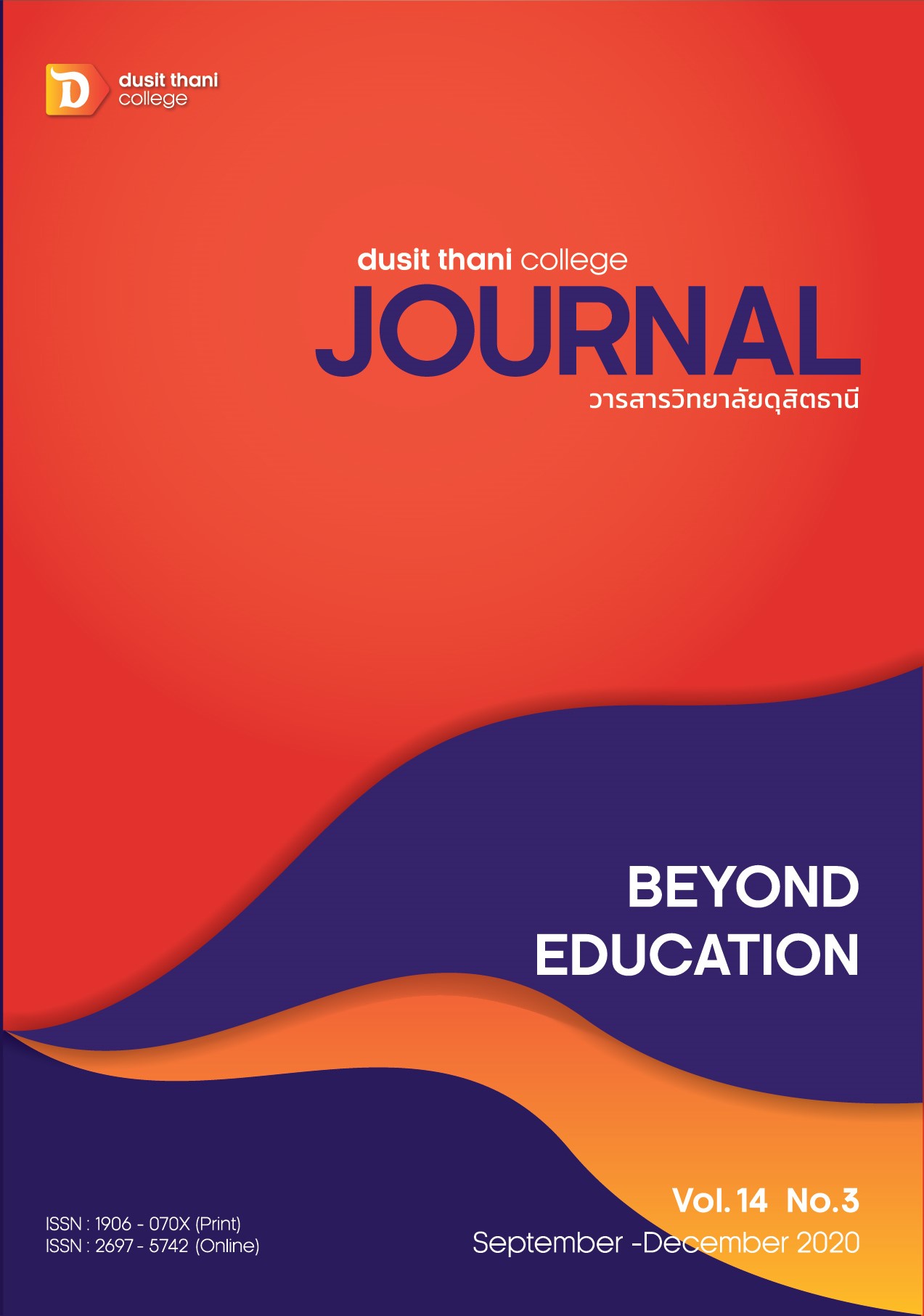บริบทการจัดการการท่องเที่ยวเพื่อพัฒนาการมีส่วนร่วมในการประกอบสร้างทุนทางสังคมเพื่อการท่องเที่ยวเชิงสร้างสรรค์กรณีศึกษาในเขตพื้นที่ตำบลเวียง อำเภอเชียงแสน จังหวัดเชียงราย
Main Article Content
บทคัดย่อ
วัตถุประสงค์การวิจัยครั้งนี้ 1) เพื่อศึกษาบริบททุนทางสังคมเพื่อการจัดการการท่องเที่ยวเชิงสร้างสรรค์ในเขตพื้นที่ตำบลเวียงเชียงแสน วิธีการวิจัยคือ 1). ประกอบด้วย แบบสัมภาษณ์กึ่งโครงสร้างเกี่ยวกับบริบทการจัดการท่องเที่ยวในเขตพื้นที่ตำบลเวียงเชียงแสน
ผลการวิจัยพบว่า การศึกษาบริบททุนทางสังคมเพื่อการจัดการการท่องเที่ยวเชิงสร้างสรรค์ในเขตพื้นที่ตำบลเวียงเชียงแสน พบว่าพื้นที่ตำบลเวียงเชียงแสนนั้นมีทุนทางสังคมที่สามารถนำมาใช้เป็นฐานในการพัฒนาศักยภาพด้านกิจกรรมการท่องเที่ยวเชิงสร้างสรรค์อยู่ 6 ประการ ประกอบด้วย 1) ทุนทางจิตวิญญาณ ได้แก่ การทำตุงไส้ช้างหรือตุงไส้หมู การทำพิธีสืบชะตา (ฮ้องขวัญ) และการทำกระสวยใส่ดอก 2) ทุนทางปัญญา ได้แก่ งานจักสาน งานปัก และงานถักทอ ภูมิปัญญาชาวบ้านเกี่ยวกับการย่ำขางและการตอกเส้น การประดิษฐ์เครื่องมือประกอบอาชีพและเทคโนโลยีชาวบ้าน และอาหารพื้นบ้าน 3) ทุนทางทรัพยากรธรรมชาติ ได้แก่ หมอพื้นบ้านที่เรียกว่า “หมอกลางบ้านหรือหมอแผนโบราณ” ซึ่งเป็นผู้ที่มีความรู้เกี่ยวยาสมุนไพร และการรักษาโรคตามภูมิปัญญาที่สืบทอดกันมา และสมุนไพรประเภทรักษาโรคทั่วไป 4) ทุนทางทรัพยากรมนุษย์ ประกอบด้วย ปราชญ์ชาวบ้านด้านการจักสาน ปราชญ์ชาวบ้านด้านพิธีกรรมทางศาสนา และปราชญ์ชาวบ้านหรือผู้เชี่ยวชาญด้านสมุนไพร และการรักษาโรค 5) ทุนทางธรรมเนียมประเพณี ความเชื่อ และศาสนา ได้แก่ โบราณสถาน และวัดสำคัญๆ และงานประเพณีสำคัญที่จัดขึ้นเป็นประจำทุกปี 6) ทุนทางภาษาวัฒนธรรม มีภาษาถิ่น “กำเมือง” หรือคำเมือง และวัฒนธรรมประจำถิ่นของชาวไทยวน ไทใหญ่ ลาว ไทลื้อ จีนฮ่อ และอาข่า
Article Details
นโยบายการพิจารณากลั่นกรองบทความ
- บทความวิจัยและบทความวิชาการทุกเรื่องที่จะได้รับการตีพิมพ์ต้องผ่านการพิจารณากลั่นกรองโดยผู้ทรงคุณวุฒิ (Peer Review) ในสาขาที่เกี่ยวข้อง จำนวน 3 ท่าน/บทความ
- บทความ ข้อความ ภาพประกอบและตารางประกอบที่ลงตีพิมพ์ในวารสารเป็นความคิดเห็นส่วนตัวของผู้เขียน กองบรรณาธิการไม่จำเป็นต้องเห็นด้วยเสมอไป และไม่มีส่วนรับผิดชอบใด ๆ ถือเป็นความรับผิดชอบของผู้เขียนแต่เพียงผู้เดียว
- บทความที่จะได้รับการตีพิมพ์จะต้องไม่เคยตีพิมพ์ เผยแพร่ที่ใดมาก่อน และไม่อยู่ระหว่างการพิจารณาของวารสารฉบับอื่น หากตรวจสอบพบว่ามีการตีพิมพ์ซ้ำซ้อน ถือเป็นความรับผิดชอบของผู้เขียนแต่เพียงผู้เดียว
- บทความใดที่ผู้อ่านเห็นว่าได้มีการลอกเลียนหรือแอบอ้างโดยปราศจากการอ้างอิง หรือทำให้เข้าใจผิดว่าเป็นผลงานของผู้เขียน กรุณาแจ้งให้กองบรรณาธิการวารสารทราบจะเป็นพระคุณยิ่ง
เอกสารอ้างอิง
Chabkrae Press.
Eiewsriwong, N. (1998). Social. The Matichon newspaper. 31 July, 1998:6.
Na Chiangmai, C. (2000). Rural Development Administration for Strengthening the Community. Bangkok: 21 Century.
Nakbutr, A. (2002). Social Capital and Prachasangkom in Thailand. Bangkok: Funds for the Society Office.
Prasongtan, S. (2013). Social Capital and Guidelines for Promoting Community base Creative Tourism: A case Study of Thai Puan People in Pakpli district, Nakhon Nayok Province. Social science journal. Srinakharinwirot University.16,pp:225-235
Raymond, R (2000). “What in a Name ? The Origins of the Term ‘Creative Tourism’ in. Wurzburger, Rebecca, et al. Creative Tourism: A Global Conversation: How to Provide Unique Creative Experiences for Travelers Worldwide. Santa Fe: Sunstone Press.
Saengsanit, N. (2011). Creative Tourism Pilot Project. Thammasat University, Bangkok.
Tinakat, P. (2014). Community-based Creative Tourism as a Tool for Sustainable Community Development. Retrieved from www.nuic.nu.ac.th/Upload/File/o39.pdf.(30th Jauary,2020)
Wasri, P. (1998). The Strategic Civil Community for Sufficiency Economy, Codes, of Conduct and Health. Bangkok: Matichon Press.
Yamane, T. (1973). Statistic: An Introductory Analysis. 3rd ed., Tokyo: Harper International Edition.


